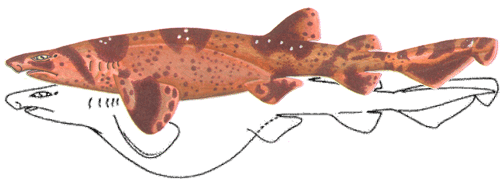Family Scyliorhinidae:
Cat Sharks 152 species
Another important group of carcharhinoids is the catsharks (family Scyliorhinidae). Catsharks are generally smallish, most less than about 3 feet (1 metre) in length. The vast majority of catsharks are oviparous, laying rectangular egg-cases with long, tangling tendrils at each corner (exceptions include the Saldanha Catshark [Apristurus saldanha], the delightfully-named Lollipop Catshark [Cephalurus cephalus] and the African Sawtail Catshark [Galeus polli], which are ovoviviparous).

Eggcases of two catsharks from the eastern North Atlantic:
TOP = the
Lesser Spotted Catshark (Scyliorhinus canicula),
BOTTOM = the
Greater Spotted Catshark (Scyliorhinus stellaris).
The scyliorhinids include one of the largest genera of sharks, Apristurus, with at least 24 and possibly as many as 47 known species. Sometimes called "ghost catsharks", the members of Apristurus are generally deep-water dwellers (down to 6,600 feet or 2,000 metres) whose life histories are poorly known and their taxonomy in need of a comprehensive revision. Much better known are the catsharks called rather curiously "dogfishes" (not to be confused with the 'true' dogfishes of the order Squaliformes, which unlike catsharks lack an anal fin). These scyliorhinids include the handsomely marked Chain Dogfish (Scyliorhinus retifer), with chocolate-brown webbing pattern on its cream-colored back and flanks, and the Lesser Spotted Dogfish (Scyliorhinus canicula), which is a moderately important foodfish in the United Kingdom, where it is harvested commercially.
The beautiful Chain Dogfish (Scyliorhinus retifer) ranges from the Georges Bank to the Gulf of Mexico and Nicaragua, appearing to be most abundant in deep waters off Virginia and North Carolina. In the northern parts of its range, it inhabits depths of 120 to 750 feet (36 to 230 metres), while in the southern parts it inhabits waters deeper than 1,500 feet (460 metres). The Chain Dogfish feeds on squid, small bony fishes, polychaete worms, and crustaceans. Recent work by José Castro and his co-workers have revealed much about the reproductive biology of this little-known shark. Castro's team discovered that males of this species reach sexual maturity at a length of about 20 inches (50 centimetres), while females mature at a length of about 20.5 inches (52 centimetres). Every 15 days or so, females lay two rectangular egg cases at a time (each about 2 inches [6 centimetres] long by 0.9 inches [2 centimetres] wide, with a long stringy tendril at each corner and a soft amber in color), anchoring them in place by wrapping the cases' tendrils around vertical bottom structures such as gorgonians, sponges, and man-made objects. At an aquarium water temperature of about 54º Fahrenheit (12º Celsius), the eggs hatch in about 256 days. Upon hatching, the pups are about 4.1 inches (10.5 centimetres) long and appear to be completely uncoordinated, suggesting they may have little protection from predators save their relatively inaccessible deep-water nursery. In the wild, juvenile Chain Dogfish are often collected by bottom trawl in large numbers over smooth mud or silt substrates. Adults of this species apparently congregate in areas with upright structures which females use for eggcase attachment. These facts suggest that Chain Dogfish nursery areas are highly localized.
Several catsharks have evolved peculiar defensive strategies. When caught and hauled to the surface, at least some catsharks of the genus Haploblepharus curl up and cover the head with the tail as though hiding or shielding their eyes, hence their common names "shysharks" and "shy-eyes". Even more dramatic are the swellsharks or balloonsharks of the genus Cephaloscyllium. Like pufferfishes, these smallish (1.5 to 3 feet, or 50 to 100 centimetres, long), slow-moving sharks can inflate rapidly. Swell sharks increase their diameter up to twice normal size by pumping large volumes of water into the cardiac (forward) portion of the stomach. Presumably this sudden increase in apparent size may startle or discourage a would-be predator, enabling the globular shark to make good its escape. Clearly, this neat trick doesn't always work - a Balloon Shark (Cephaloscyllium sufflans) was removed from the stomach of a coelacanth. The Swell Shark (Cephaloscyllium ventriosum), a common species off central to southern California, goes one step farther: when threatened, this species dives into any available rocky crevice, bends its body into a sharp U-shape with head and tail innermost, grasps its caudal fin in its mouth and inflates. This maneuver presents to the outside world a sharkskin innertube that - rounded and wedged securely into place - is difficult to bite or otherwise forcibly evict.

The Swell Shark (Cephaloscyllium ventriosum), like other members of its genus, is able to suddenly increase its volume by swallowing large quantities of seawater as an anti-predator tactic. If caught and hauled to the surface rapidly, it may inflate itself with air instead of water - which works just as well but is noisier to expel afterward. There are reports of a closely related species, the Draughtsboard Shark (C. isabellum) from New Zealand, that actually barks like a large dog. This sound may be due to air escaping explosively past the sphincter which controls the passage of food in and water or air in and out of the stomach. It is difficult not to resist imagining a solitary Maori fisherman, rowing shoreward after a successful night's fishing on a moonless night ... when suddenly, inexplicably, a hoarse barking like an agitated St. Bernard erupts from somewhere in the bow, just beyond his feet where his vision cannot penetrate the darkling light.
In proportion to its length, the Swell Shark (Cephaloscyllium ventriosum) has a mouth that is proportionately larger than that of the notorious White Shark (Carcharodon carcharias). The Swell Shark has been observed rushing open-mouthed through schools of small fishes, catching them at the mouth corners and swallowing them whole. This one seems to be contemplating whether it could swallow the photographer!
Photo © Jeremy Stafford-Deitsch; used with the gracious permission of the photographer, who asks that you support the Shark Trust.


